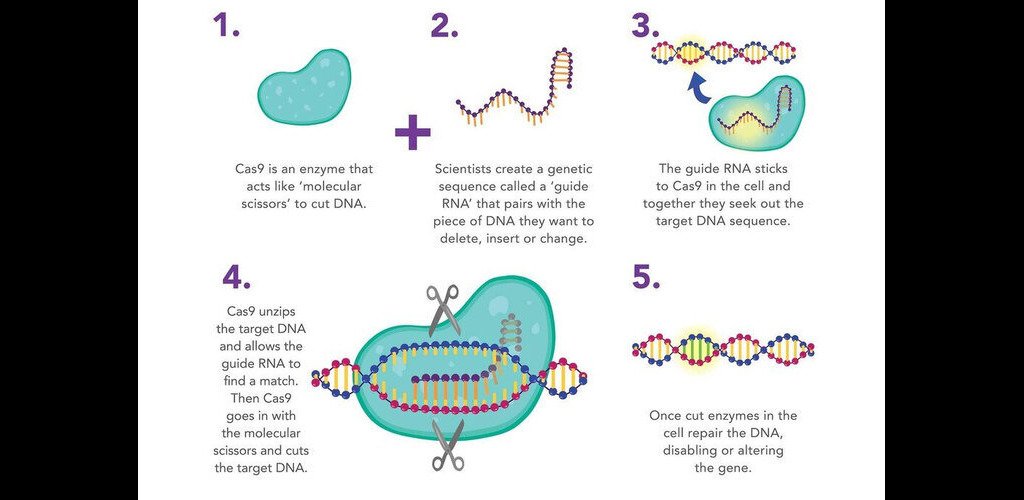CRISPR (Bunched Consistently Interspaced Short Palindromic Rehashes) is a progressive device in hereditary design that has fundamentally progressed our capacity to control DNA with accuracy, productivity, and relative simplicity. Here is a complete glance at CRISPR’s job in hereditary designing:
1. What is CRISPR?
CRISPR is a characteristic guard system tracked down in microscopic organisms and archaea. These creatures use CRISPR arrangements as a component of their resistant framework to perceive and fend off infections (bacteriophages). The framework comprises two fundamental parts:
- CRISPR sequences: short, dreary DNA groupings that contain scraps of viral DNA.
- Cas proteins (especially Cas9): These are particular chemicals that can cut DNA. Cas9, for instance, goes about as sub-atomic scissors that can be directed to explicit areas in the DNA.
2. How CRISPR Works in Hereditary Engineering
In hereditary design, CRISPR is saddled to target and alter explicit qualities. The cycle includes two primary advances:
- Guide RNA (gRNA): An engineered RNA particle that is intended to match the objective DNA succession in the genome.
- Cas9 protein: This protein is directed by the gRNA to the designated DNA succession, where it makes an exact cut, permitting scientists to either debilitate qualities or supplant them with new hereditary material.
3. Applications of CRISPR in Hereditary Engineering
CRISPR’s capacity to target explicit qualities has prompted notable advances in different fields of hereditary design.
a. Quality Editing
- Quality Knockouts: Analysts can “take out” qualities by prompting twofold strand breaks in the DNA, prompting loss-of-capability transformations. This is urgent for concentrating on the capability of explicit qualities.
- Quality Addition/Replacement: CRISPR can likewise be utilized to embed or supplant qualities. After a break is made in the DNA, a contributor DNA succession can be presented, empowering exact hereditary changes.
b. Sickness Exploration and Therapeutics
- Hereditary Disorders: CRISPR has shown a guarantee in treating hereditary issues like sickle cell frailty, cystic fibrosis, and Duchenne strong dystrophy by amending the transformations answerable for these sicknesses.
- Malignant growth research: CRISPR is being utilised to make more exact disease models for research and to foster potential treatments that target disease cells.
- Physical Cell Editing: Includes altering the genome of non-conceptive cells to treat illnesses in people, without giving these progressions to posterity.
c. Horticultural Engineering
- Crop Improvement: CRISPR is utilized to make hereditarily changed crops with wanted characteristics like protection from bugs, dry spell resistance, and upgraded dietary substances. This can increment food security and diminish dependence on synthetic pesticides.
- Animal Modifications: CRISPR has been utilised to make hereditarily adjusted creatures that are impervious to sicknesses (like pigs impervious to PRRS) or have improved development rates and other advantageous qualities.
d. Manufactured Biology
- CRISPR is likewise applied in manufactured science to design microorganisms to create important substances, for example, biofuels, drugs, or modern proteins.
4. Advantages of CRISPR in Hereditary Engineering
- Precision: CRISPR permits profoundly designated changes to the genome, lessening the gamble of askew impacts contrasted with more seasoned procedures like TALENs or ZFNs (zinc-finger nucleases).
- Efficiency: The CRISPR cycle is generally fast and practical, empowering high-throughput hereditary alterations in both model living beings and bigger creatures.
- Flexibility: CRISPR can be utilised to change practically any life form, from microorganisms to plants, creatures, and, surprisingly, human cells, making it exceptionally adaptable.
- Multiplexing: CRISPR can at the same time target and adjust various qualities in a single trial, making it exceptionally effective for complex hereditary changes.
5. Challenges and Moral Considerations
a. Off-Target Effects
- While CRISPR is exceptionally exact, accidental changes to the genome (off-target impacts) can happen, prompting likely dangers, like the presentation of destructive transformations.
b. Germline Editing
- Altering the human germline (sperm, eggs, or incipient organisms) could prompt inheritable changes, raising worries about unseen side effects, moral issues, and the chance of “creator infants.”
- There are worldwide discussions about whether genetic altering ought to be permitted, given its drawn-out suggestions for people in the future.
c. Openness and Equity
- There are worries about how open CRISPR-based advances will be, especially concerning their reasonableness and dispersion, and whether they could compound worldwide disparities, especially in medical care and farming.
d. Regulation
- Various nations have differing guidelines on the utilization of CRISPR, especially in human quality altering, prompting difficulties in global approach-making and exploration of morals.
6. Future of CRISPR and Hereditary Engineering
The fate of CRISPR holds enormous potential in changing medication, farming, and biotechnology. A few energizer possibilities include:
- Customized Medicine: CRISPR could be utilized to address hereditary deformities in patients, prompting customised medicines for various hereditary illnesses.
- Worked on Rural Sustainability: CRISPR can be utilized to design yields and animals to be stronger to environmental change, bugs, and infections, further developing food security around the world.
- High-level helpful development: CRISPR could prompt the advancement of quality treatments for conditions that at present have no fix, like specific hereditary problems and, surprisingly, a few types of malignant growth.
conclusion
CRISPR is perhaps the most amazing asset in hereditary designing today, with the capacity to alter qualities in practically any living being. Its flexibility, productivity, and potential to change fields like medication, farming, and biotechnology make it a central member coming soon for hereditary science. Notwithstanding, the moral and administrative difficulties related to its utilisation, particularly in human hereditary adjustments, need cautious thought as we push ahead with this groundbreaking innovation.
